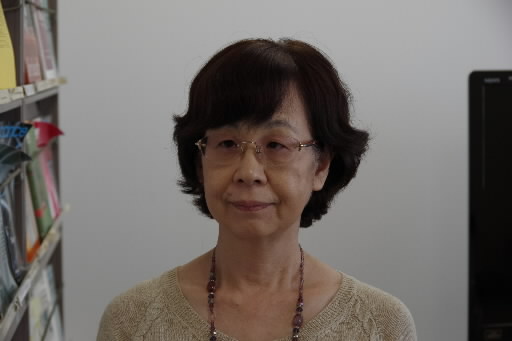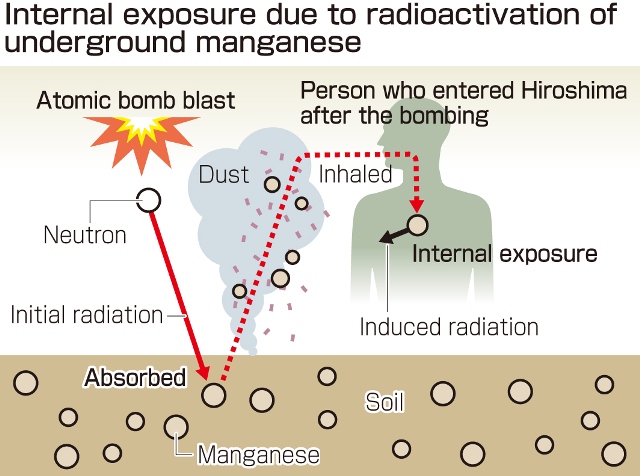Manganese is chief cause of radiation exposure for people who entered Hiroshima on August 6, study finds
Oct. 18, 2013
by Yota Baba, Staff Writer
Research indicates that young and middle-aged males who were exposed to the atomic bomb’s radiation after entering Hiroshima on August 6, 1945 run a higher risk of dying from cancer compared to men of the same age brackets who entered Hiroshima on August 9 or later. This finding is the result of a study by a team of experts that includes Keiko Otani, an assistant professor at Hiroshima University’s Research Institute for Radiation Biology and Medicine (RIRBM) and an expert in statistics. The research team also found that manganese was the major cause of residual radiation, to which people who entered the city in the aftermath of the blast were exposed.
The study looked at 47,000 people who entered the city after the blast and whose conditions were confirmed between 1970 and 2011. These people were divided into four groups according to the day they entered Hiroshima: August 6, 7, 8 and 9 or later. Each group was further divided by gender and age. The researchers then compared their rate of dying from cancer, excluding leukemia.
Men who were then between 30 and 49 and entered the city on August 6 had a higher risk of dying from cancer at the age of 75 compared to those in other groups. The risk was higher by 18 percent for men who were 30 years old at the time, and by nearly 40 percent for men who were 40.
To explain the reason for these differences, the research team sought to identify the major element responsible for radiation exposure in the wake of the bombing. The half-life (the amount of time required for half of the radioactive particles to decay) of manganese is about 2.5 hours. This means the radioactivity of this element was still high on August 6, but fell to nearly zero on August 7. This dovetails with the fact that only those who entered the city on August 6 had a higher risk.
Manganese is an element that is abundant in soil. When neutrons from the atomic blast were absorbed by the nuclei of manganese, radioactive manganese was created.
Sodium and scandium, which had been considered sources of radiation exposure, have half-lives of 15 hours and 83.8 days, respectively. They were removed from the list, since this cannot explain why only those who entered the city on August 6 had higher risks.
Many young and middle-aged males were engaged in relief efforts near the hypocenter after the bombing, searching for victims and rescuing the injured. According to Ms. Otani, as they took part in these activities, they may well have suffered internal exposure by inhaling dust which contained radioactive manganese. Referring to the differences in the risk between those who entered the city on August 6 and on 7 or later, she said, “The effects of residual radiation cannot be ignored.”
These findings will be presented during the annual meeting of the Japan Radiation Research Society, which will open in the northern city of Aomori on October 18.
New findings add momentum to research on internal exposure
Comment made by Masaharu Hoshi, a professor emeritus at Hiroshima University and a specialist in radiation biology and physics
This research has produced a significant result in the study of internal exposure by statistically ruling out the possibility that sodium is the source. Inhaling radioactive manganese contained in dust could lead to an increase in cases of lung cancer. Analysis of organs will help strengthen the veracity of the research.
(Originally published on October 12, 2013)
Research indicates that young and middle-aged males who were exposed to the atomic bomb’s radiation after entering Hiroshima on August 6, 1945 run a higher risk of dying from cancer compared to men of the same age brackets who entered Hiroshima on August 9 or later. This finding is the result of a study by a team of experts that includes Keiko Otani, an assistant professor at Hiroshima University’s Research Institute for Radiation Biology and Medicine (RIRBM) and an expert in statistics. The research team also found that manganese was the major cause of residual radiation, to which people who entered the city in the aftermath of the blast were exposed.
The study looked at 47,000 people who entered the city after the blast and whose conditions were confirmed between 1970 and 2011. These people were divided into four groups according to the day they entered Hiroshima: August 6, 7, 8 and 9 or later. Each group was further divided by gender and age. The researchers then compared their rate of dying from cancer, excluding leukemia.
Men who were then between 30 and 49 and entered the city on August 6 had a higher risk of dying from cancer at the age of 75 compared to those in other groups. The risk was higher by 18 percent for men who were 30 years old at the time, and by nearly 40 percent for men who were 40.
To explain the reason for these differences, the research team sought to identify the major element responsible for radiation exposure in the wake of the bombing. The half-life (the amount of time required for half of the radioactive particles to decay) of manganese is about 2.5 hours. This means the radioactivity of this element was still high on August 6, but fell to nearly zero on August 7. This dovetails with the fact that only those who entered the city on August 6 had a higher risk.
Manganese is an element that is abundant in soil. When neutrons from the atomic blast were absorbed by the nuclei of manganese, radioactive manganese was created.
Sodium and scandium, which had been considered sources of radiation exposure, have half-lives of 15 hours and 83.8 days, respectively. They were removed from the list, since this cannot explain why only those who entered the city on August 6 had higher risks.
Many young and middle-aged males were engaged in relief efforts near the hypocenter after the bombing, searching for victims and rescuing the injured. According to Ms. Otani, as they took part in these activities, they may well have suffered internal exposure by inhaling dust which contained radioactive manganese. Referring to the differences in the risk between those who entered the city on August 6 and on 7 or later, she said, “The effects of residual radiation cannot be ignored.”
These findings will be presented during the annual meeting of the Japan Radiation Research Society, which will open in the northern city of Aomori on October 18.
New findings add momentum to research on internal exposure
Comment made by Masaharu Hoshi, a professor emeritus at Hiroshima University and a specialist in radiation biology and physics
This research has produced a significant result in the study of internal exposure by statistically ruling out the possibility that sodium is the source. Inhaling radioactive manganese contained in dust could lead to an increase in cases of lung cancer. Analysis of organs will help strengthen the veracity of the research.
(Originally published on October 12, 2013)









